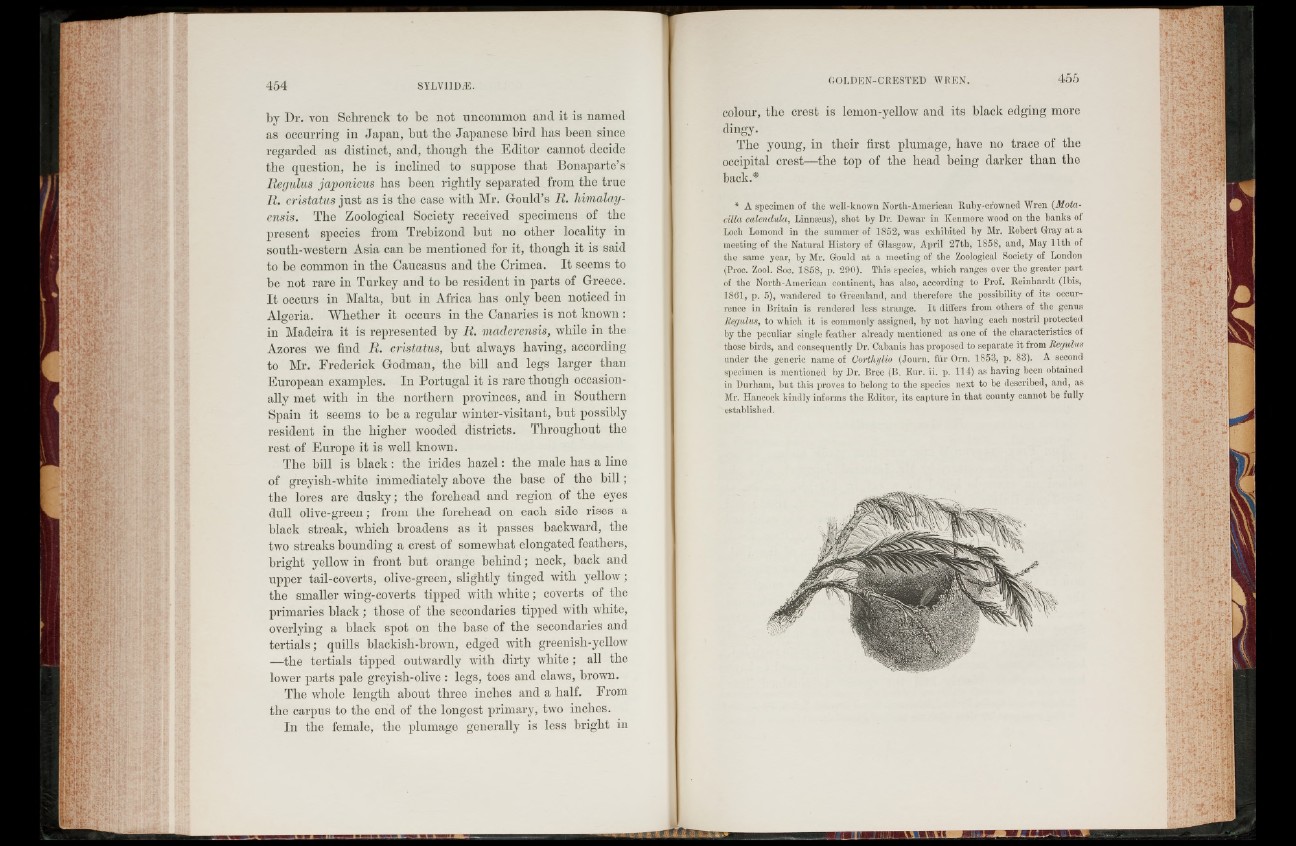
by Dr. von Schrenck to be not uncommon and it is named
as occurring in Japan, but the Japanese bird has heen since
regarded as distinct, and, though the Editor cannot decide
the question, he is inclined to suppose that Bonaparte’s
Regulus japonicus has been rightly separated from the true
li. cristatus just as is the case with Mr. Gould’s 11. himalay-
ensis. The Zoological Society received specimens of tlxo
present species from Trebizond but no other locality in
south-western Asia can he mentioned for it, though it is said
to be common in the Caucasus and the Crimea. I t seems to
be not rare in Turkey and to be resident in parts of Greece.
I t occurs in Malta, but in Africa has only been noticed in
Algeria. Whether it occurs in the Canaries is not known :
in Madeira it is represented hy li. maderensis, while in the
Azores we find 11. cristatus, hut always having, according
to Mr. Frederick Godman, the bill and legs larger than
European examples. In Portirgal it is rare though occasionally
met with in the northern provinces, and in Southern
Spain it seems to be a regular winter-visitant, but possibly
resident in the higher wooded districts. Throughout the
rest of Europe it is well known.
The bill is black: the irides hazel: the male has a line
of greyisli-wliite immediately above the base of the h ill;
the lores are dusky; the forehead and region of the eyes
dull olive-green; from the forehead on each side rises a
black streak, which broadens as it passes backward, the
two streaks bounding a crest of somewhat elongated feathers,
bright yellow in front but orange behind; neck, back and
upper tail-coverts, olive-green, slightly tinged with yellow;
the smaller wing-coverts tipped with white; coverts of the
primaries black ; those of the secondaries tipped with white,
overlying a black spot on the base of the secondaries and
tertials; quills blackish-brown, edged with greenish-yellow
—the tertials tipped outwardly with dirty white ; all the
lower parts pale greyisli-olive : legs, toes and claws, brown.
The whole length about three inches and a half. From
the carpus to the end of the longest primary, two inches.
In the female, the plumage generally is less bright in
GOLT)EN-CRESTED WREN. 455
colour, the crest is lemon-yellow and its black edging more
dingy.
The young, in their first plumage, have no trace of the
occipital crest—the top of the head being darker than the
back.*
* A specimen of the well-known North-American Ruby-cfowned Wren (Mota-
cilia calendula, Linnaaus), shot by Dr. Dewar in Kenmore wood 011 the banks of
Loch Lomond in the summer of 1852, was exhibited by Mr. ltobert Gray at a
meeting of the Natural History of Glasgow, April 27th, 1858, and, May 11th of
the same year, by Mr. Gould at a meeting of the Zoological Society of London
(Proc. Zool. Soc. 1858, p. 290). This species, which ranges over the greater part
of the North-American continent, has also, according to Prof. Reinhardt (Ibis,
1861, p. 5), wandered to Greenland, and therefore the possibility of its occurrence
in Britain is rendered less strange. I t differs from others of the genus
Regulus, to which it is commonly assigned, by not having each nostril protected
by the peculiar single feather already mentioned as one of the characteristics of
those birds, and consequently Dr. Cabanis has proposed to separate it from Regulus
under the generic name of Corthylio (Journ. fur Orn. 1853, p. 83). A second
specimen is mentioned by Dr. Bree (B. Eur. ii. p. 114) as having been obtained
in Durham, but this proves to belong to the species next to be described, and, as
Mr. Hancock kindly informs the Editor, its capture in that county cannot be fully
established.
.V .
■
I : a ll
, “h i